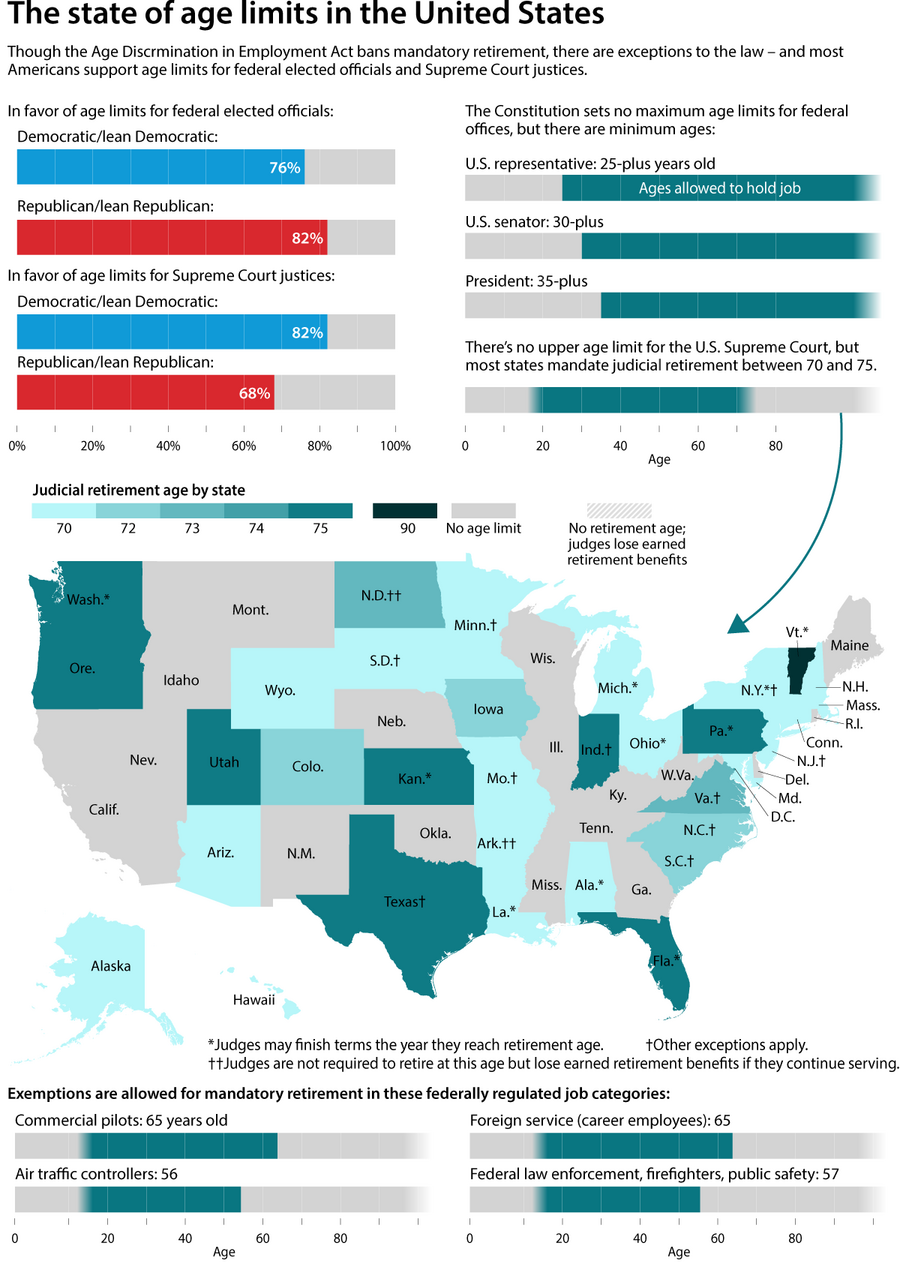Biden says he’s ‘too old to stay as president.’ It shows the pull of ageism.
Loading...
A year of intense concern about the fitness of older national leaders to serve, culminating in President Joe Biden pulling out of the White House race, has surfaced what experts on aging see as a snowballing and largely unchallenged expression of the ageism that permeates American culture.
It’s not that the public is uniformly skeptical of octogenarians, like Mr. Biden. From politicians to business leaders and pop stars, many figures of older age enjoy wide acceptance as they continue to campaign, invest, and rock on. But gerontological advocates and scientists say public perceptions of older people are far too often anchored in unfair assumptions about the meaning of a numerical age, or about a slowing body equating with being slower of mind.
And those who study aging say that’s increasingly noticeable in public discourse.
Why We Wrote This
Intense scrutiny of veteran politicians has prodded America toward greater awareness of how unchallenged ageism affects everyone, not just presidential candidates.
For example, pressure for Mr. Biden to withdraw probably had more to do with changing perceptions of his capabilities than with how many times he’s circled the sun. But the proliferation of the words “too old” in headlines, memes, political polling, comedy routines, and social media became ageist shorthand. Indeed, Mr. Biden himself bought into the shorthand in his Democratic convention speech Monday: “Now I’m too old to stay as president.”
“Too old,” aging experts say, is a stereotype as unjust and incorrect as generalizations about race or gender. Except race and gender discrimination is widely unacceptable, while ageism is the “last acceptable prejudice.” And it equates chronological age with poor health, which in turn fans fears of growing older.
Yet even some of those who see rampant ageism – and its cousin “ableism,” with biases about disability – also see opportunity in the current moment.
“I personally think unless you see [ageism], you’re not going to do anything about it,” says Tracey Gendron, a gerontologist at Virginia Commonwealth University and author of “Ageism Unmasked.” “So, the positive here is that it raises awareness that ageism and ableism are freely floating throughout society.”
Monitor conversations with a half-dozen professionals studying the physical, mental, and social aspects of aging echoed Dr. Gendron’s dismay and hope.
Ageism is at least an increasingly familiar word. But Dr. Gendron says, “This whole conversation around politics has really set us back a step or two. Because you’re seeing so much more rhetoric about ‘too old.’”
Paul Kleyman, a journalist who has monitored ageism in the media for decades, dates the beginning of the spike in ageist rhetoric to the “legitimate worries” about the health of the late California Sen. Dianne Feinstein, which “turned speculative about other older members of Congress with no medical basis.”
“Those of us concerned about unanswered ageism in American culture watched the narrative load to a trigger point since early 2022, as we’ve not witnessed before. The Biden debate [performance] to me was a match to a kindling pile,” he says.
To some, the shift is that ageism has become more visible, not necessarily more widespread.
“I’m not sure ageism itself is on the increase. I think we’re paying more attention to what’s been there all along, and that Biden’s frailty supercharged the issue,” observes “This Chair Rocks” author and activist Ashton Applewhite.
How unchallenged ageism damages the public conscience
A World Health Organization report in 2018 targeted ageism as a pervasive global problem – “socially accepted and usually unchallenged.” Its effects, said the WHO, reverberate through economies in added health care costs and lost job opportunities, and it damages the public conscience of older and younger populations who internalize negative age beliefs.
The American gerontology field has understood this and worked assiduously in recent years to scientifically “reframe” aging positively.
Among problems these experts focus on are the effects of age segregation, from solitary isolation to grouping in islands of over-age-55 developments; and the antiaging – or “against aging” – health and beauty culture that pitches fear of growing older, even creating the “Sephora kids” tween market for wrinkle serums.
Some keep an eye on issues of fairness in such things as mandatory retirement or certifications for older people to drive or perform their work, and all concern themselves with how broadcasts of ageism are internalized among old and young alike.
Political reporting often “off the mark” over the past year
Politics have been the source of an “outbreak of ageism,” says James Appleby, CEO of the Gerontological Society of America, who, like his colleagues, spends much time managing misconceptions. “We get so comfortable with [stereotypes] that we never actually see what we’re doing. But for the [gerontological] community, a widespread feeling now is, ‘Wow, can you believe how off the mark some of the reporting can be?’”
Intense focus in the past year on struggling older politicians like the late Senator Feinstein, Senate Minority Leader Mitch McConnell, and President Biden often conflated their chronological age with missteps, physical appearance, and questions of health and cognition. With Mr. Biden, age 81, out of the race now, there’s evidence the age focus is being turned on former President Donald Trump, age 78. CNN commentator and former Obama White House adviser David Axelrod said before Mr. Biden’s convention speech, “Now the worn-out old incumbent is Donald Trump.”
And this all keeps aging professionals busy, repeating their singular mantra in interviews and op-eds: “If you’ve seen one 80-year-old, you’ve seen one 80-year-old.”
The point, explains antiageism author Ms. Applewhite, is that “the defining characteristic of aging is heterogeneity. ... There are as many ways to be 80 as there are 80-year-olds.”
That diversity is overlooked when the term “too old” is used to collapse aging “into a set of clichés and tropes,” explains Brian Carpenter, professor of psychological and brain sciences at Washington University in St. Louis. “It’s a stand-in for other things that I think they’re really concerned about, which is capability, cognition, energy, vitality.”
But, he adds, “It takes a lot more mental effort to think about a person’s experience, or their connections to world leaders, or their prior experience managing a crisis. It’s just harder for people to evaluate our candidates on those much more complex, abstract principles.”
Likewise, in political polling, experts say questions that lead voters to consider a candidate through the age lens are ageist because they misleadingly equate age with capability. An ABC News poll in early July by Langer Research Associates, for example, directly asked if respondents thought either, both, or neither of the presidential candidates was “too old” for a second term. Fully 58% responded “both.” (Neither the polling firm nor ABC responded to interview requests.)
“That’s not an informative way of framing the question, and it implies that there’s something useful about knowing someone’s chronological age, which really isn’t very valuable when evaluating someone’s leadership capabilities,” asserts Dr. Carpenter.
A catalyst for deeper conversations
There is the possibility that Mr. Biden’s pullout, which he referred to as passing the torch “to a new generation ... new voices, fresh voices – yes, younger voices,” will give momentum to public policy efforts to define “too old.”
“Should we have age limits?” asks Steve Austad, a biologist and longevity researcher at the University of Alabama. “I don’t think so. Perhaps there are good reasons to have them, but they’re unfair to a lot of people.”
He adds, “I also don’t think it would be a bad national conversation to have ... as an opportunity to combat ageism.”
Dr. Austad says he was “intrigued” recently to discover one example of inconsistencies in age limits: There are mandatory retirement ages for judges in 32 states – and two states require forfeiture of retirement benefits if judges don’t retire at a certain age. But none of those states have mandatory retirement age limits for the legislators who set those limits.
Airing and clarifying what “too old” really means – or doesn’t – might raise consciousness about ageism’s societal effects, gerontologists say.
“Internalized ageism” in older people, says Dr. Carpenter, citing studies, “can change their behavior, their cognition, their physical activity, their willingness or desire to pursue certain things in life.”
Conversely, that research also shows that cultivating “positive age beliefs” can significantly change those effects.
Dr. Carpenter and his colleagues worry that ageist messages also influence the mindsets of younger people who, as they age, will also struggle with the gap between stereotypes and scientific facts about healthy aging.
“I am hopeful that maybe this will be a catalyst [that] will open the door to having more serious conversations about what ageism actually looks like and how it impacts us at all levels,” says Dr. Gendron.
This article was written with the support of a journalism fellowship from the Gerontological Society of America, the Journalists Network on Generations, and the Silver Century Foundation.









